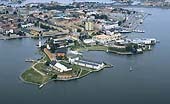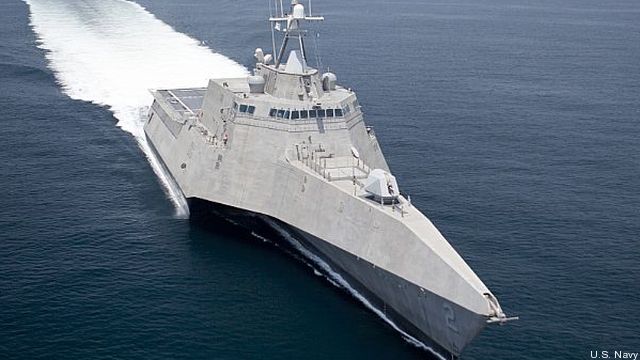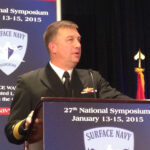| KOTA KINABALU: The Royal Malaysian Navy (RMN) Submarine Base now has a fully functional Scorpene Class Submarine maintenance facility in South East Asia. The refit facility was completed by Trans Resources Corporation Sdn Bhd (TRC) on January 14 after work began on September 8, 2014. It comprises three blocks that contain seven workshops to conduct maintenance and repair on piping, hull, machine, combat systems, composite, paint and battery, as well as offices and changing rooms. Yesterday Naval Chief, Admiral Datuk Seri Ahmad Kamarulzaman Ahmad Badaruddin visited the base to inspect the first refit work at the facility on the KD Tunku Abdul Rahman submarine. The facility is located at the Boustead DCNS Naval Corporation Sdn Bhd dockyards. Kamarulzaman said the maintenance facility in Sabah would save the Navy from having to send submarine components or parts abroad for maintenance. “The completion of the facility makes the Submarine Base the best Scorpene base in the region,†he said, adding that the dockyards could accommodate 250 people at any given time. Refitting work of submarines is carried out locally and involves maintaining and repairing 14,000 components. Kamarulzaman said it would provide exposure and opportunities to local industries involved in the maintenance of submarines. “This will reduce dependence on foreign skill and labour and hence save outward cash flow from the country,†he added. Further, the work which also includes local labour proved Malaysia’s capabilities in performing any given job and was one way to help protect the nation’s highly confidential strategies. “It also proves the expertise of our local defence industries and can boost confidence among Malaysians on our submarines. “For instance, the dock workers use a robot, which is manufactured by a company in Terengganu to clean the hull of the submarine and even the French engineers have acknowledged that this is an achievement because even they still clean submarine hulls manually in France,†he said. He explained that the current condition and appearance of submarines actually depicted that the submarine had been underwater many times. “I know many people doubt whether our submarines can actually submerge but I assure you they can submerge. Even now, the KD Tun Razak is currently on an operation and it is actually underwater. “The Submarine Force utilises every opportunity it has to go on subsurface operations,†he said, adding that he might one day have members of the media given the opportunity to be on the submarine when it goes on a subsurface mission. Kamarulzaman was touring the Sepanggar Naval Base for the first time as Naval Chief since he assumed the post on November 18, 2015. He was accompanied by the Region 2 Naval Commander, Rear Admiral Datuk Khairul Anuar Yahya and Submarine Force Chief, Rear Admiral Datuk Abdul Rahman Ayob as well as senior naval officers. Kamarulzaman, previously held the post of the First Region Naval Commander 2 in Kota Kinabalu as well as being Joint Forces Chief in charge of the security of Sabah and Sarawak waters. He was also directly involved in Ops Daulat during the Lahad Datu intrusion in 2013. Earlier, a parade was held at the Naval Base to welcome him followed by a speech from Kamarulzaman to the officers and personnel serving at the Kota Kinabalu Naval Base. He then attended the handing over ceremony of the Auxiliary Vessel Bunga Mas Lima. Also present with him were Boustead DCNS Naval Corporation Chief Executive, Jean-Luc Bianchini and member of the Board of Directors of the Sabah Housing and Town Development Authority (SHTDA), Datuk Seruji Nawawi. |
| By : CLEOPHAS JOHN GORDON |
| New sabah Times |
star Sunday, 27 December 2015

THE world is changing fast, and so are the security challenges and issues facing our Royal Malaysian Navy.
The new chief of the RMN, however, is taking everything in his stride.
“The Navy must adapt. The security threats are redefining the way we manage modern armies,” Admiral Datuk Seri Ahmad Kamarulzaman Ahmad Badaruddin tells The Star at his office in Wisma Pertahanan.
Likening himself to the captain of a ship, Admiral Ahmad Kamarulzaman who was appointed the 16th RMN chief in November, says the captain and the ship, in this case the Navy, would have to operate as one to meet its goal to be a world class Navy.
“However, I always look at challenges as opportunities.” he notes, stressing that his appointment is a huge responsibility that he will work hard to fulfil.
When did you join the Navy?
In 1977, 38 years now. Thirty eight years of exciting, exhilarating, challenging years. I am blessed to be in the Navy these many interesting years. For me, personally, it has been a very enriching experience. I wouldn’t want it any other way. Come to think of it, I was a cadet with the RMC (Royal Military College) and here I am at the helm of the RMN.
What was the first thing that came across your mind when you were appointed Navy chief?
I was like, is this real? Thank God, it is. For a navy person, that is the pinnacle of achievement. I have not known anything else but wearing the Navy uniform with pride and honour for almost four decades. But with the appointment comes a very heavy responsibility.
I would like to look at it as amanah (trust) that is entrusted upon me. In Islam,amanah is something that one will be made accountable to God for his deeds.
The way I look at it, the position of the Chief of the Navy is not a privilege, it is in fact a burden of trust. I’m merely the captain of a ship. The Navy is an institution, not unlike a ship, and the Navy People are the ship’s crew.
I am a believer in teamwork, more so in a ship that sails along choppy and dangerous waters at times - the Captain has to ensure discipline and to bring out the best in the people.
What is your plan or strategy for the Navy?
We are mindful of the changing dynamics in the world’s realpolitik, so too the security challenges of the day. The Armed Forces, and especially the Navy, must adapt. The security threats are redefining the way we manage modern armies. Our “enemies” too are evolving and adapting. There are simply too many challenges today to warrant a new thinking in how we manage our affairs.
It cannot be business as usual. Under current scenarios where regional territorial issues are becoming contentious, we need the Navy to be on an excellent state of preparedness. You ask me, are we perfect? We are not, but within that imperfections, we are thriving for the best. But I can assure you that we are fully-prepared and we are ever ready to face any challenges. Yes, taking that into consideration, the Navy has embarked on a comprehensive, strategic plan that extends up to 2020. For now, I intend to ensure that we meet the objectives of the current plan known as PS1320 (Strategic Plan 2013-2020).
What are the main challenges facing the Navy today?
Modern Armed Forces, especially the Navy, need to be equipped with the best technologies – state-of-the-art, cutting-edge ones, if you like. We are not talking about the Chinese armada of the Ming dynasty or the ones that the English had during the sea battles at Waterloo against Napoleon Bonaparte. The battles for supremacy in the Pacific or the Atlantic oceans during the Second World Wars were part of the annals of great warfare.
But things are changing now. Technology is changing how we fight wars on land and in the sea. We have to equip our Navy with the best equipment and train our people to manage new methodology in warfare strategies. In short, we need money. Don’t worry about the morale. We have the best people with us.
To be honest, one of the immediate challenges that we are facing now is the fiscal one because of the global economic conditions that have impacted the Malaysian economy. It will affect the budget for the Armed Forces as well as the Navy.
However, I always look at challenges as opportunities. In this regard, the opportunity that I see is to adopt a firmer and more practical measures in managing our operational expenditures.
The other challenge, is that we are managing an aging fleet. I must admit many of our ships are over 30 years - considered old by international standard. Yes, we hope to replace them immediately.
But we do understand that it will have to be done in phases depending on our financial capabilities but we can’t wait too long.
We have to understand that we have a huge area to protect because Malaysia is primarily a maritime nation. The East Coast of Sabah alone covers a shoreline of about 1,600 km. That is three times the length of PLUS Highway from Johor Bahru to Bukit Kayu Hitam.
Therefore, we have to look at innovative and creative ways to mitigate these challenges.
Can you name one of the innovative and creative ways that the Navy has taken?
There are many but one of the excellent example is the Sea Basing concept in managing the maritime security in the Eastern Sabah. We are proud of the outcome of the (sea bases) Pangkalan Laut Tun Sharifah Rodziah and Tun Azizan.
Before this, we had this constraint where our boats took a long time to respond to an incident out at sea because they are based in Semporna, Sandakan and Tawau.
Sometimes it takes the boats up to two hours or more depending on the weather conditions to arrive at the trouble spots from their bases.
Now, with the sea bases out there, we have reduced the response time drastically. The sea bases also provide deterrence to any would-be perpetrator wanting to come into our water. This concept was actually realized within a year thanks in part because of the personal attention given by (Defence Minister) Datuk Seri Hishammuddin (Hussein) himself. We are happy that Petronas is collaborating with us on this, based on the National Blue Ocean Strategy or NBOS.
The sea bases, one of which is a MOPU (mobile offshore production unit), has been converted into a platform that not only provides accommodation facilities but also many others facilities to support naval operation. This includes command and control functions, surveillance and interdiction capabilities. It also provides logistical support to other agencies including the Army, MMEA, Marine Police. It now has enhanced the Situational Awareness in the area with 24/7 surveillance and also interdiction and interception capabilities with the interceptor boats operating from it.
How many bases under the sea basing concept is the Navy operating and are there any plans to expand the concept?
Currently, we have two sea bases, Tun Sharifah Rodziah is the MOPU, whilst Tun Azizan is a converted container ship. We want to collect enough data and gather enough operational experience and feedback, which we will then need to study before deciding additional numbers and locations.
What is your vision for the Navy?
I want a world class Navy and a Navy that Malaysians can be proud of. I want a Navy that is battle-ready at all times. I want a Navy that has personnel that are trained in the latest sophistication and gadgetry as in any modern day navies. Nothing less will satisfy me. But I am a practical and pragmatic person too. We can’t have the best of everything, but we have to work hard towards that. We must build human capital capabilities that reflect our vision of the future. The Navy sometimes plays second fiddle to the other “brothers” in the Malaysian Armed Forces. Not many realise what our roles are. Sometimes we have been the unsung heroes among the uniformed brethren. That has to change too. We need to be more “joint” to achieve multiplier effect.
What about the people? Do you think they understand what you guys are doing?
I want a people’s Navy. That is why we want to reach out to the people on the need for them to understand and support us. The incursions in Sabah few years ago was a wake-up call. People realised we do need a credible maritime force. And the Navy is an equally critical element of this force in the defence of this beloved nation. I think after what happened in Sabah, people begin to understand us more than ever before. But, the defence of the nation requires more than what the Armed Forces or security forces could possibly do. The public can and should contribute as well.
Thus, we are engaging the people in other ways too. We have an initiative that we called the Inisiatif Bertanya Khabar (IBK). It is a very simple concept of engaging the public especially involving the maritime community.
We do things that look insignificant, but matter a lot to people. I look at this approach as small effort, high impact. Let’s say, we are trying hard to show a new face – a friendly face. It goes a long way when you are out there among the waves for fishermen and people on the move in the open seas. We engage people in small talks when we have the opportunity, perhaps even asking them if they have any problems and how we can help. They would then be our “eyes and ears”.
The RMN cyber team has been established to monitor its personnel in a bid to curb the spread of Islamic State ideologies. Can you explain further on it?
Future wars are to be fought by computers and technologies. I am a believer in that. And yes, the threat of IS is real. Then again, prevention is better than cure. We must explain to people why the threats are real. Why young people are radicalised. Why some convoluted “Islamists” - they are not fit to be called that anyway - are using Islam to kill and destroy others. This is not Islam.
Is the effort already ongoing and did you detect any activities?
Yes, we take such treats seriously from within and from without. It is our own effort in support of the other agencies to monitor and counsel our personnel. We are using all platforms available including KAGAT (Religious Corp in the Armed Forces) to spread the words of goodness in Islam. On the need to understand what real jihad is all about. The word itself has now being hijacked and abused thus bringing forth the negative connotation. In actual fact, “jihad” is a noble word to mean a fight for a worthy cause, in whatever endevours.
There is a number of military personnel arrested for their involvement in IS. How problematic is it for the Navy?
The number is small but just like a Malay saying: “seekor kerbau membawa lumpur, semua terpalit (A buffalo carrying a dirt will affect the entire herd). But when it involves the military or even the police, the perception is not good. We should be aware that the security personnel is a good target for the IS as we are well trained especially in handling of weapons and other military skills.
Personally, I don’t think it is a serious problem. But we cannot let our guard down.
There has been quite a few hijacking and piracy incidents in South China Sea and the Straits of Malacca. How is the Navy tackling the problem with the assistance of MMEA and Marine Police?
We are not denying it. We are in fact very concerned about it. In the Malacca Straits, it has been relatively safe compared to previous years. However, the number of incidents off the East Coast of Malaysia, in the South China Sea have increased over the last few years.
Obviously it is of concern to us. Even though it is under the purview of the MMEA (Malaysia Maritime Enforcement Agency) the Navy contributed significantly as we have more ships. But we now need to enhance our information and intelligence sharing not only with other agencies but also neighbouring countries. We need to work together better as many of the cases are syndicated activities. So the solution may not be at sea but on land, thus requiring a concerted efforts, across agencies and across borders.
The tension between the super powers in the South China Sea has been a hot topic lately, and took centre stage during the Asean Defence Ministers Meeting (ADMM). What are the measures taken by the Navy to prevent unwanted incidents or provocation in the area?
I think people need to understand the issues better. When we talk about certain reports of foreign ship intrusion in our waters, we have to understand the definitions of waters. There is the Exclusive Economic Zone (EEZ) which is up to 200 nautical miles from the coast or island.
The other is our Malaysian Territorial Waters which is up to 12 nautical miles. If ships, whether warships or any other ships, are transiting the EEZ, that is within the United Nations Convention on the Law of the Sea (UNCLOS). There’s nothing to prevent them from passing by or being around but as long as they do not do something to interfere or impacts our security and defence. The Navy, Air Force and MMEA will usually monitor their movements, but people should not be overly worry about it, unless it impacts on our security. The thing that we have to be concerned is when they encroach into our Malaysian Territorial Waters without approval or valid reason.
And we also need to understand that part of our EEZ are within the overlapping claim with few other nations. There is ongoing diplomatic process as the issues are complex. However, all the nations involved agreed that it should be solved diplomatically and not militarily, We have good relations with all these nations, politically, economically and well as socially.
What is your hope for the Navy?
I hope the Navy will continue to be the pride of the nation and that we will strive to be better in delivering our services for the Rakyat. I also hope for more non-Malays to join the Navy and Armed Forces. I remember during my time when I joined the Navy, there were a number of non-Malays and we were all working as a team. We were all very high spirited.
We are so proud of them. But looking at the statistics now, not many non-Malays are willing to join the military. Thus, the Navy, is committed to support the 1Malaysia concept by getting more non-bumiputras to join the Navy. We are even going down to Chinese and Indian schools and using NGOs to try to engage the relevant communities in a more effective manner. Our Chinese and Indian officers are also doing their part to change these perceptions. This is a Navy that embraces all regardless of race and religion. This is OUR Navy.





 Once the Littoral Combat Ships got upgunned, the enemy commander could no longer afford to ignore them, explained McGrath, a
Once the Littoral Combat Ships got upgunned, the enemy commander could no longer afford to ignore them, explained McGrath, a 

